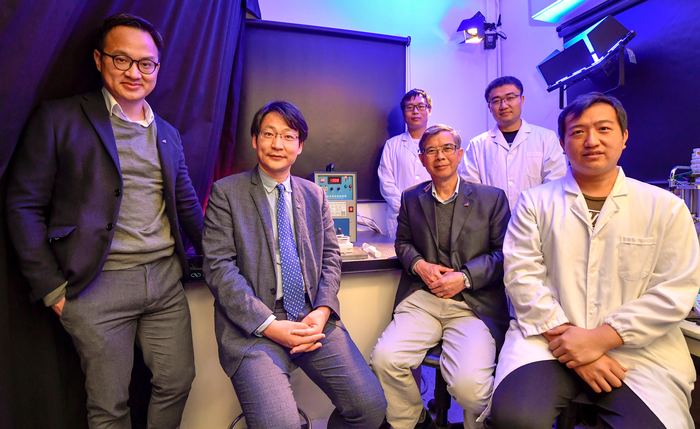A structured thermal armor (STA) has been recently created by a research group headed by scientists from the City University of Hong Kong (CityU). It is capable of achieving efficient liquid cooling of more than 1,000 °C, basically resolving a 266-year-old challenge posed by the Leidenfrost effect.
 Members of the CityU research team: (from left in front row) Dr. Steven Wang, Professor Wang, Professor Pan Chin, Dr. Jiang Mengnan (from left in back row) Mr. Liu and Mr. Li. Image Credit: City University of Hong Kong.
Members of the CityU research team: (from left in front row) Dr. Steven Wang, Professor Wang, Professor Pan Chin, Dr. Jiang Mengnan (from left in back row) Mr. Liu and Mr. Li. Image Credit: City University of Hong Kong.
This breakthrough could be employed in aero and space engines, as well as enhance the reliability and security of next-generation nuclear reactors.
The study has been headed by Professor Wang Zuankai from CityU’s Department of Mechanical Engineering (MNE), Professor David Quéré from the PSL Research University, France, and Professor Yu Jihong, Director of the International Center of Future Science, Jilin University, and Senior Fellow of the Hong Kong Institute for Advanced Study at CityU.
The study findings were reported in the latest issue of the highly renowned scientific journal Nature.
The Leidenfrost effect is a physical phenomenon that was discovered in 1756. It denotes the levitation of drops on a surface that is considerably hotter compared to the boiling point of the liquid. It generates an insulating vapor layer and drastically decreases heat transfer performances at high temperatures.
This is responsible for making liquid cooling on the hot surface ineffective. This effect is mostly considered to be harmful, and it has stayed as a historic challenge to subdue this effect.
The CityU-headed group fabricated a multitextured material along with main elements that consist of contrasting geometrical and thermal properties. The rational design for the STA superimposes strong, conductive and protruding pillars that act as thermal bridges for encouraging heat transfer.
It also has an enclosed thermally insulating membrane that has been developed to suck and evaporate the liquid; and underground U-shaped channels that empty the vapor. It seems to be successful in hindering the happening of the Leidenfrost effect ranging up to 1,150 °C and obtains efficient and controllable cooling throughout the temperature range from 100 °C to over 1,150°C.
This multidisciplinary research project is truly a breakthrough in science and engineering, since it mixes surface science, hydro- and aero-dynamics, thermal cooling, material science, physics, energy and engineering. Searching for novel strategies to address the liquid cooling of high-temperature surfaces has been one of the holy grails in thermal engineering since 1756.
Wang Zuankai, Professor, Department of Mechanical Engineering, City University of Hong Kong
Professor Wang Zuankai added, “We are fortunate to fundamentally suppress the occurrence of the Leidenfrost effect and thereby provide a paradigm shift in liquid thermal cooling at extremely high temperatures, a mission that has remained uncharted to date.”
Professor Wang noted that the present thermal cooling strategies, under extremely high temperatures, tend to adopt air cooling measures instead of effective liquid cooling as a result of the occurrence of the Leidenfrost effect. This seems to be particularly suitable for applications used in next-generation nuclear reactors as well as aero and space engines.
The designed STA can be fabricated to be flexible, eliminating the need for additional manufacturing, especially for those surfaces that are hard to be textured directly. This is why the STA possesses huge potential for practical applications.
Wang Zuankai, Professor, Department of Mechanical Engineering, City University of Hong Kong
The corresponding authors of the paper are Professor Wang, Professor Quéré, and Professor Yu. The first authors are Dr. Jiang Mengnan and Dr. Wang Yang from MNE.
The collaborators of the study are Professor Pan Chin, Head, Dr. Steven Wang, Assistant Professor, Zhang Huanhuan, Research Assistant, Liu Fayu and Li Yuchao, Ph.D. students, from CityU's MNE; and Professor To Suet and Du Hanheng, Ph.D. student, from the Department of Industrial and Systems Engineering, Hong Kong Polytechnic University.
Journal Reference:
Jiang, M., et al. (2022) Inhibiting the Leidenfrost effect above 1,000 °C for sustained thermal cooling. Nature. doi.org/10.1038/s41586-021-04307-3.